Super Bowl IX - Pittsburgh Steelers vs Minnesota Vikings: Pregame
This series covers the history of the NFL through the prism of its yearly championship games.
Note: The gray boxes contain asides that provide interesting material but could be skipped
without losing the continuity of the article.
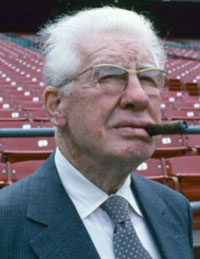
Art Rooney Sr.
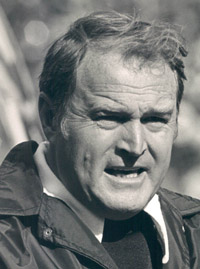
Chuck Noll
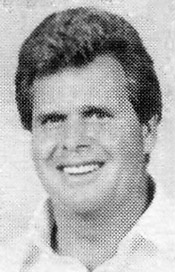
Dick Haley
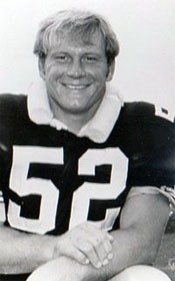
Mike Webster

Bill Nunn
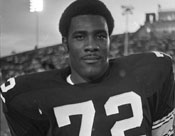
Joe Greene
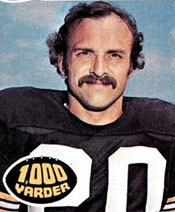
Rocky Bleier
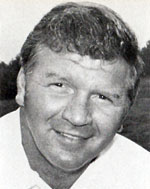
George Perles

Andy Russell
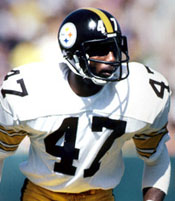
Mel Blount
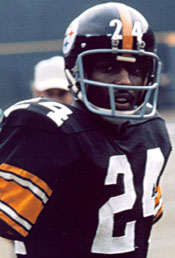
J. T. Thomas
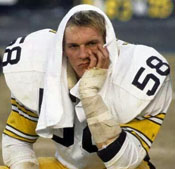
Jack Lambert
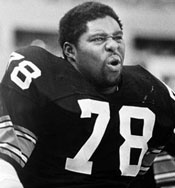
Dwight White
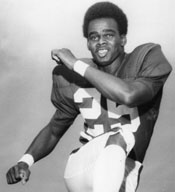
Jackie Wallace
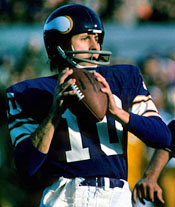
Fran Tarkenton
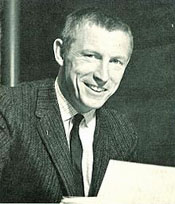
Jerry Burns
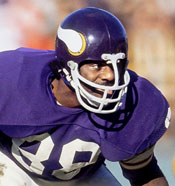
Alan Page
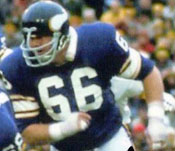
Andy Maurer
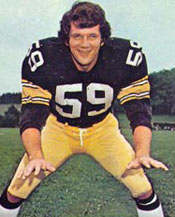
Jack Ham
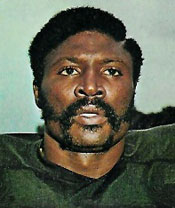
Glen Edwards
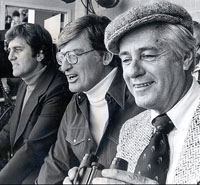
Don Meredith, Al DeRogatis, Curt Gowdy


|
Arthur Joseph Rooney Sr., known as " The Chief," had been a winner all his life in everything except football.
- From a devout Irish Catholic family in Pittsburgh, Art bought an NFL franchise for $2,500 in 1933 - supposedly from his winnings at gambling and the racetrack. A great raconteur, he was friendly and lovable, the favorite NFL owners to his peers and sportswriters.
Art had won the AAU welterweight boxing championship in 1918 and tried out for the 1920 Olympic team. He also was a player-manager on a minor league baseball team and halfback for a semipro football team.
- His Pittsburgh Pirates, who became the Steelers in 1940, were perennial doormats of the NFL. The 1947 club tied for the Eastern Division championship but lost to the Philadelphia Eagles 21-0 in the playoff. The '62 Steelers under Buddy Parker finished second in the East before descending back to the bottom of the division in subsequent years.
- The tide finally turned in 1969 when 37-year-old Chuck Noll became the coach, although the results at first didn't show it. Noll played for Paul Brown in Cleveland before serving as a defensive assistant to two other excellent coaches - Sid Gillman of the San Diego Chargers and Don Shula of the Baltimore Colts.
Noll most closely imitated Brown, although with a lesser ego. Chuck kept a certain distance from his players while emphasizing meticulous organization, structure, and fundamentals. He eschewed pep talks and idle chatter.
- Working with Director of Player Personnel Dick Haley, Noll presided over some of the finest drafts in NFL history. They produced 15 players to would make 71 Pro Bowl appearances.
- 1969 - Joe Greene, an obscure defensive lineman from North Texas State who was chosen with pick #4 in the first round. Other notable choices were DE L. C. Greenwood and T Jon Kolb.
- 1970 - QB Terry Bradshaw with the first pick and DB Mel Blount in the second round.
- 1971 - LB Jack Ham in round 2, DE Dwight White (round 4), T Larry Brown (Round 5), and DT Ernie Holmes (Round 8).
- 1972 - RB Franco Harris (round 1).
- 1973 - DB J. T. Thomas (round 1).
- 1974 - WR Lynn Swann (round 1), MLB Jack Lambert (round 2), WR John Stallworth (round 4), C Mike Webster (round 5) - all four in the Hall of Fame, making this undoubtedly the best draft by a team in NFL history.
The Steelers' successful drafts were due in no small measure to Bill Nunn, the sixth black scout in pro football. As a sportswriter for the Pittsburgh Courier, one of the nation's most influential black publications, Bill started putting together a "Black College All-America team" for the Courier in 1950. To make the best selections possible, he traveled the country scouting black players in person. His annual list became a valued source of information for a number of pro teams preparing for the draft. But the Steelers were not in that number until 1967 when Art Rooney Jr. hired him as a part-time scout. With his extensive connections to black coaches throughout the nation, Nunn suggested most of the black players that Pittsburgh stockpiled the next six years. Haley acknowledged Bill's contribution. Bill Nunn was one of the best moves the Steelers could have made. All of a sudden, to all of the great black players in the country, the Steelers were one of the premier teams.
- The Steelers went 1-13 in Noll's first year but jumped to 5-9 the next season and 6-8 in 1971.
- The breakthrough came in 1972 when an 11-3 record propelled the Steelers to the first playoff appearance in franchise history. The "Immaculate Reception" upset of the Raiders put them in the AFC championship game, which they lost to the undefeated Dolphins.
- The '73 club finished 10-4, but fell to the Raiders in the first round of the playoffs.
- The Steelers finally won the AFC in '74. After thumping Buffalo 32-14 in the first round, the Steelers upset the Raiders in Oakland 24-13 to earn their first trip to the Super Bowl.
Harris recalled years later: That win over Oakland showed the league and the entire country how good we were. And we proved it to ourselves. Because of the Oakland game, I had confidence in our team and ... I wasn't as nervous going into the Super Bowl ... We'd made so many tough runs and catches and defensive plays against Oakland that I felt that we were on a roll. I was feeling pretty secure and it never crossed by mind that we weren't going to win it.
It's unusual for a football team to reach the championship game in a season in which it had three different starting QBs. But that's what happened to the '74 Steelers.
- After Terry Bradshaw joined other players in striking for a week during the preseason, Noll stunned Steeler nation by designating Joe Gilliam his starter for the start of the regular season. Even Bradshaw agreed that Gilliam had performed much better in the preseason games.
Gilliam became the first black QB to start his team's first game of an NFL season. His selection was provoked a negative reaction from a number of Steeler fans who weren't ready for a black QB. Bradshaw told reporters he'd like to be traded.
- But after a loss and a tie in the first two games, Joe was only 8-for-31 with 2 INTs in the 17-0 home loss to the Raiders. Still, Noll stuck with Gilliam through three more victories before returning Bradshaw to the starting lineup.
Noll later revealed that Gilliam had started abusing drugs, which cost him the trust of his teammates.
- Bradshaw won his first two starts but lost his job again after a terrible outing in a loss at Cincinnati: 13-for-35 for 140y, 0 TDs, 1 INT. Noll turned to Terry Hanratty, who was abysmal at Cleveland. He threw more INTs (3) than completions (2) in 15 attempts for only 63y.
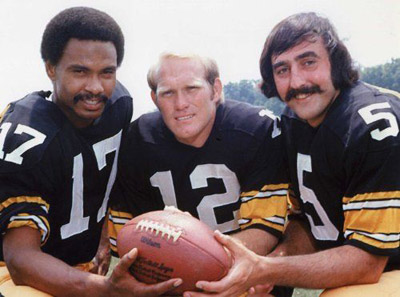
L-R: Joe Gilliam, Terry Bradshaw, Terry Hanratty Harris recalled: The Steelers were a close team, with great athletes who were also great people. We hadn't been divided because of the changing QB situation.
- With a suffocating defense and an outstanding running game, the Steelers could win with average productivity from its QB. So Bradshaw took over for the rest of the march to the Super Bowl. Noll didn't exactly give his QB a ringing endorsement when he told the press, We've got to keep our defense playing good offense.
His teammates noticed a big chance in Terry's attitude after his six-weeks "exile" to the bench. RB Rocky Bleier: When he got back into the lineup, his presence in the huddle was dramatically different. And in the locker room, he was suddenly friendlier, more down-to-earth, feeling less pressured to do it all himself. Paul Martha, a retired Steeler, put it this way. Bradshaw had just been divorced, he was going bald, everybody was saying he was dumb. He looked the situation over and said, "The hell with it. I'm just gonna play football. That's all I have left.
The Pittsburgh defensive unit that went to four Super Bowls in six years starting in 1974 is considered one of the greatest, if not the greatest, in NFL history.
- D-line coach George Perles designed the "Stunt 4-3 defense." Joe Greene added his own wrinkle to the alignment for the title game against Oakland. He lined up in the gap between the C and G but turned at an angle toward the C, as shown in the picture below.
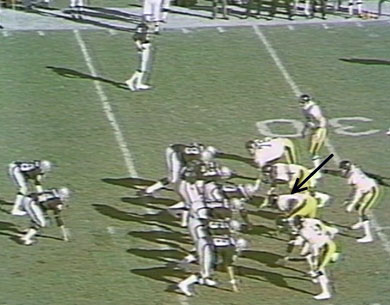
Steelers' 4-3 Defense with the Tilted Tackle
- Andy Russell recalled how the "Tilted Tackle" came about. This offset alignment was something Joe developed himself, out of frustration. ... He hated to get blocked and wanted to make plays. So it occurred to him that, because he was so quick, he should just line up inside, between the center and the guard, tip his shoulder sideways, and when the ball was snapped, he'd just dart through that hole. He was supposed to line head-up on the guard. He jumped in the gap between the guard and center, tilted his body, and just blew through that gap, and it was devastating. It was a beautiful thing to see.
- Greene added: We found out that with my lining up in it, I could demand a double-team. The only way you can command a double is to not let the center overblock you, get in across your face.
- Noll explained that the Steelers' 4-3 was an aggressive defensive play because our front four isn't sitting and reading the offense. Instead they're the ones making things happen.
Defensive coordinator Bud Carson added his "Cover-Two" pass coverage to a powerful front line to complete the Steel Curtain. Cover-Two was based on these principles.
- Defensive linemen provide all the pressure. Blitzing is rarely used.
- The front four line up in gaps to make it more difficult for holes to open up, forcing RBs to run outside where corners, LBs, and safeties can make tackles. Carson's unit of Greenwood, Greene, Holmes, and White did that better than any other quartet in the league.
- CBs line up just across the line of scrimmage from receivers and try to jam them to force them out of their patterns and into the strength of the defense. This approach required big, physical CBs, and Carson had those in Mel Blount (6-3, 205) and J. T. Thomas (6-2, 195).
Carson's Cover-Two would spread so quickly through the league that the rules were changed in 1978 to allow contact with receivers only within 5y of the line of scrimmage. This became known as the "Mel Blount Rule."
- The two safeties play a deep-zone coverage, splitting the width of the field 50-50. They need the speed and strength to defend passes but also close on running backs. Steeler safeties Mike Wagner and Glen Edwards possessed those skills.
- The MLB had to cover the vulnerable area in front of the safeties on pass plays while still plugging the middle against runners who slip past the front four. Jack Lambert added this final piece to the puzzle when he was drafted in 1974. Taller (6-4) but lighter (225) than the MLB prototype exemplified by Ray Nitschke and Dick Butkus, Jack, in the words of fellow LB Andy Russell, could blanket TEs man-to-man and run with them down the middle.
- Carson's defense required all eleven players to read plays before the snap so that they were rarely fooled by traps or misdirection. He also changed alignments from game to game or even in the middle of games. His Steel Curtain units were smart and talented enough to make the adjustments.
DB Tony Dungy, a future Super Bowl champion coach, joined the Steelers in 1977. A lot of times, you didn't even know what coverage you were going to play when you came out of the huddle. It depended on the formation the offense was in, and you had to get those checks on the run.
For the second year in a row and the third time in six years, the Minnesota Vikings represented the NFC in the Super Bowl.
Like the Steelers, the Vikings were built around their defense, second best in the NFC in points allowed.
- That unit had only one change from 1973: Rookie Jackie Wallace replaced Bobby Bryant at RCB.
- Fran Tarkenton continued to lead the offense, which finished second in the NFC in scoring. Tarkenton, age 34, presented a stark contrast to Bradshaw, eight years his junior. Confident almost to a fault, Fran was famous for his spontaneity, a trait he developed behind the porous offensive line of the expansion Vikings when he often had to scramble from a collapsing pocket. His first pro coach, Norm Van Brocklin, said of him: He will lose games he should win and win games he should lose. And so he will always be a 7-7 QB. But Fran proved that wrong in his second tenure with Minnesota when given a much stronger supporting cast.
- While Bradshaw was ill-at-ease with reporters, Tarkenton loved to talk to them.
He explained: Every QB has got critics. That's why QBs are able to do more after 30. Before that, if you win it's nice, if you lose it isn't. And when you lose, people criticize you. When you're younger, you're wondering why people don't like you. You hear that you can't throw deep. You can't read defense, you can't lead the team. ... I've seen a lot of QBs beaten down. It happens to a lot of kids who never play after their 20s. Look at Earl Morrall. There never has been a passer more abused that Earl Morrall when he was in his 20s. Fran's attitude was illustrated by an answer he gave when the Vikings arrived in New Orleans. A reporter asked, Strictly off the record, is this just another game? Tark replied, When I was a kid, it was something I always wanted to do. I'm just so happy I'm going to kick Joe Greene's butt.
- Surprisingly, DE Alan Page sounded a discordant note: This team is not as good as our other two Super Bowl teams. It is my opinion, just a feeling I have.
- Pittsburgh Director of Player Personnel Tim Rooney recalled: The Vikings were kind of like a mirror image of us ... I viewed us as a very young team and them as a very mature team with a stoic coach in Grant. Containing Tarkenton was going to be a real big factor.
The Vikes had their famed Purple People Eaters up front, but the Steelers boasted of their Steel Curtain.
- The entire Black and Gold front four were African-Americans drafted from small colleges in the South.
- LE L. C. Greenwood - Arkansas-Pine Bluff (10th round 1969)
- LT Joe Greene - North Texas State (1st round 1969)
- RT Ernie Holmes - Texas Southern (8th round 1971)
- RE Dwight White - Texas A&M-Commerce (4th round 1971)
Greene was the undisputed leader of the Steelers, as testified by multiple players. Franco Harris: Joe Greene was one of the leaders on the team and had been since his rookie year. ... he set the tone on and off the field for the entire team. We definitely looked up to him. I liked that he could always put things into perspective ...
- Those four were backed by an exceptional set of LBs.
- LLB Jack Ham (2nd round 1971)
- MLB Jack Lambert (2nd round 1974)
- RLB Andy Russell (16th round 1963)
In the AFC Championship Game, the Steel Curtain held the Raiders to just 29y in 21 rushing attempts. The Steelers offense gained 224y on the ground.
- The Vikings would have a difficult time moving the ball on the Steelers when at full force, but injuries forced them to move LG Charles Goodrum to LT and start journeyman Andy Maurer at LG.
The two "old school" coaches took opposite approaches in managing the week in New Orleans before the game.
- Grant located his team at the Airport Hilton far from the French Quarter and imposed a curfew every night.
- Recalling his experience as an assistant on the Colts team that was upset by the Jets in Super Bowl III, the last thing Noll wanted was an overconfident team that would play not to lose. So Chuck announced that there'd be no curfew and no bed check the first three nights in New Orleans, then a midnight curfew the rest of the week. Further, the players had Monday and Tuesday off and their wives could stay with them in their hotel rooms. So the youthful Steelers hit Bourbon Street hard, gorging themselves on Crescent City food and drink and staying out until the wee hours.
Andy Russell recalled: By the time we started practicing on Wednesday, we were begging for a bed check.
But Wednesday's practice was so sloppy that Noll stopped it midway and told everyone, Maybe we can get our heads together and come back for a good practice tomorrow.
- One Steeler couldn't enjoy the revelry. Soon after arrival in New Orleans, DE Dwight White collapsed in pain in the lobby of the team hotel. Greene carried him to a cab and took him to a hospital, where Dwight was diagnosed with viral pneumonia. He lay in a hospital bed for three days, during which he lost 20 pounds. He tried to participate in the Thursday practice but couldn't last past 15 minutes. Doctors told Noll there was no way White could play on Sunday. So Steve Furness practiced with the first unit.
One of the programs that White might have watched on the TV in his hospital room the night before the game was the Mary Tyler Moore Show, which was set at a TV station in Minneapolis. The plot involved a character betting a large amount on the Steelers in the Super Bowl against the Vikings and losing. As the credits rolled, Mary read a disclaimer: If the Pittsburgh Steelers win the actual Super Bowl tomorrow, we want to apologize to the Pittsburgh team and their fans.
- The Steelers also faced another distraction. Each player was allotted four Super Bowl tickets with the option to buy 20 more at $25 a ticket. Before leaving Pittsburgh, many players sold their extra tickets for $150 each to travel agents. Others, looking to make a bigger profit, brought their tickets to New Orleans, where they hawked them to ticket brokers. But any ducats not sold by Sunday morning dropped in value quickly to as little as $5 because of the weather. About 1,000 tickets went unsold, and several Steelers had to eat most of the extra tickets they bought.
Generally condescending toward the press, both coaches held press conferences in New Orleans because the NFL required them.
- Noll was asked, Is there a way to tell you how your team might respond since it's their first (in the Super Bowl)? Chuck responded: I can't tell if the players are ready to play emotionally. Can you? I've given up trying. You win this game with good, basic, fundamental football. There's a lot of hoopla to the Super Bowl, but it all comes down to blocking and tackling. If you didn't know who said it, you might think it was Bud Grant.
- The Steelers head man proclaimed his squad ready and loose. This is our first time, and we are an enthusiastic group. It's what we've strived for the past four years. All this distraction by the press and photo boys doesn't affect us. In fact, we love it. It's part of the glamor of being a participant in the celebrated classic.
- Chuck headed off any QB controversy by stating that Bradshaw would go all the way. I called him into my office after he had such a fine game against New Orleans here on a Monday night. At that time, I told him he was my No. 1 QB. The team accepted the decision and really got behind him. It's been a successful experience.
Bradshaw predicted: If I have a good game, we're going to win the Super Bowl. Sensitive to criticism since he entered the league that he was too dumb to lead a championship team, he pointed out that he called his own plays, which many "smart" QBs weren't allowed to do. However, the confident front he displayed was just that, a front. He later wrote: Even though it was Pittsburgh's first division championship in 42 years, the whole affair had a hollow ring to it. I was delirious with joy for the club, but in no way did I feel I had been a major factor in getting there. I guess I agreed with one of the writers who said words to the effect that a tackling dummy playing QB could have gotten the job done with the running attack and the defense we had. ... I was interviewed and ... a lot of people asked me pretty much the same line of questions. It was all centered around my ability, or lack of ability, as a QB. Did I have confidence? Could I get the job done? Fran Tarkenton was smart and Terry Bradshaw was dumb. It was basically a simple script: The Steelers had a tough defense and good runners and "Terry, do you think you'll foul things up?" ... each night, I prayed just for strength to endure each day.
But Terry commanded more respect from his teammates than he gave himself credit for. Harris: Bradshaw was a leader on the offense. At times, you would suggest things to him on the sidelines, but he was the one who ran things on the field. ... Brad always was emotional and some people would worry about that affecting his performance, but during games I saw him as businesslike. He could be a calming influence ...
Rocky Bleier told a TV reporter: Terry's really come into his own this season. He used to get very excited and uptight, sometimes even stuttering in the huddle. We'd have to settle him down. But this year, he's very cool and calm. He seems to have everything under control. Now he calls the plays with full command. Against Oakland, for instance, he called about thirty percent audibles.
- Grant, who once said that QBs are not God Almighty, objected to the media giving so much attention to Tarkenton. The media make a big thing out of QBs. We don't. If you didn't know better, the speaker could have been Chuck Noll.
Unlike Noll, Grant didn't meddle in the offensive side of the ball, leaving that to Jerry Burns. Tarkenton: I don't know that Bud could diagram five plays.
- Bud was told by a questioner that his former GM, Jim Finks, had predicted that this may be the last hurrah for the aging Vikings. You wouldn't make up a quote would you? asked Bud. We grow old gracefully.
- Grant came alive when a reporter asked a question about hunting and fishing. He expressed regret that he couldn't have a shot at some of the big marsh rabbits that abound in southern Louisiana or trying to land some of the big fish swimming off the Louisiana coast. He also denied going hunting the morning that Minnesota played the Rams for the NFC championship. I don't know where that story originated. ... It's a very relaxing sport, and I would have liked nothing better. But on the day of a championship game - nothing doing.
|
Minnesota's Super Bowl experience kept the point spread in favor of the youthful Steelers to just three points.
The NFL accepted New Orleans' bid for the 1975 Super Bowl with the assurance that the Superdome would be built in time.
- But the new facility would not be available until the '75 football season. So the game was played in Tulane Stadium.
- When the Steelers and Vikings woke up Sunday morning, rain was falling and the temperature was dropping to the mid-40s.
- The hard rain stopped by game time, but the skies stayed overcast and a persistent drizzle continued along with 17mph winds that made the wind chill 22.
Jack Ham: It was an ugly day - rained all day ... It didn't dampen it for me or any player on our football team, what we were trying to do, why we were there, or what we were trying to accomplish ... Ham's fellow LB, Andy Russell, simply recalled that he loved the weather that day. It probably froze most of the spectators. Of course it was very invigorating for the players.
- The morning rain made the artificial turf slippery in spots despite an attempt made to vacuum off the water.
Pittsburgh equipment manager Tony Parisi had prepared for the rain by ordering new shoes with extralong cleats.
Players spent the agonizing hours in the locker room before the 2 PM kickoff in different ways.
- Some fell asleep at the foot of their lockers. But Terry Bradshaw was not one of that group. He was so nervous he hyperventilated, had sweaty palms, and a bout of diarrhea. He even smoked a cigar to try to relax. He told himself: Don't you lose this game! Don't you dare lose this game! He also repeated the three-word mantra a hypnotist had taught him: Relax. Confidence. Concentrate.
- Chuck Noll had exuded confidence all week. I never saw a guy so loose, observed one reporter. Those expecting a fiery pregame speech in the locker room were disappointed. He gave the same speech he made for the first exhibition game of the season, recalled trainer Ralph Berlin. The coach closed by telling his men to go out and have some fun.
- The Steelers did receive inspiration from the appearance of a teammate they never thought would play in the game. Dwight White begged doctors to release him from the hospital because, as he told his girlfriend by phone, he might never have the opportunity to play in the Super Bowl again. Down to 220 pounds, he called Berlin to pick him up Sunday morning and bring him to Tulane Stadium. Dwight wanted to at least be in uniform and be introduced with the starting defense. The doctor told Berlin, Let him get dressed. What can happen? He'll play three or four plays, and we'll take him back to the hospital.
- White went through warm-ups, then joined the defensive line. We're going through everything like it's a normal game, he recalled. They said, "OK, Dwight, do you think you can make it?" And I'm like, "Yeah, I can make it. Start the game."
As they gathered in the same tunnel to enter the field, the two teams presented a stark contrast in demeanor.
- Many of the Steelers were rowdy and laughing and couldn't wait to play football. The Vikings to a man were grim and silent.
An incident in the tunnel illustrates the difference in attitude between the two teams.
Steelers S Glen Edwards decided to say hello to Vikings G Charles Goodrum, a college teammate at Florida A&M. Glen wished him well but received only a cold stare in return. Looking at the Vikings, Glen said, What's wrong with you guys? When he still got no response, he said, Okay, then, buckle up! J. T. Thomas, who had felt a palpable fear among his teammates as they waited next to the Vikings, recalled, We went crazy. It was on in the tunnel. The Steelers would vote Edwards their MVP for the 1974-75 season.
Bleier recalled: When we were standing in the tunnel at old Tulane Stadium, I wanted to pinch myself. Here I was, a kid from Appleton, Wisconsin, part of the legacy. ... It was like, wow - this is the great thing!
Bradshaw: This was my first Super Bowl, and I had been dreaming about it my entire life. ... I looked forward to the public-address announcer's voice reverberating throughout the entire stadium: Forrr the Steellllerrrrs, at quarterback, nummmberrrr 12, Terrreeeeey Bradshaw ... my adrenaline was pumping faster than oil in the Middle East. ... I was really nervous. ... Rather than exuding confidence, all I thought was, Don't lose this game, don't lose this game, don't you dare lose this game.
- As the teams waited to be introduced, a shirtless fan wearing the trademark Viking horned helmet collapsed in the stands from a massive heart attack next to the Steelers. Other fans tried to help him, to no avail.
Bradshaw: The man dropped dead right in front of me! He died with his horns on. And it didn't stop the program for one second.
NBC telecast the game with Curt Gowdy doing play-by-play, Al DeRogatis and Don Meredith providing commentary, and Charlie Jones roaming the sidelines.
- Sponsors paid a record $107,000 for a 30-second commercial during the telecast.
- The telecast attracted an estimated 56 million viewers.
The pregame show featured the Grambling marching band. The national anthem was sung by the New Orleans Mardi Gras Chorus of the Society for the Preservation and Encouragement of Barber Shop Quartet Singing in America.
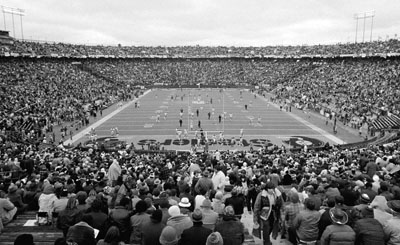 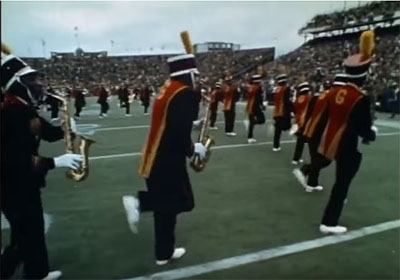
| # |
Player |
Pos. |
Hgt. |
Wgt. |
College |
Exp. |
| 5 |
Terry Hanratty |
QB |
6-1 |
210 |
Notre Dame |
6 |
| 10 |
Roy Gerela |
K |
5-10 |
185 |
New Mexico State |
6 |
| 12 |
Terry Bradshaw |
QB |
6-3 |
215 |
Louisiana Tech |
5 |
| 17 |
Joe Gilliam |
QB |
6-2 |
185 |
Tennessee State |
3 |
| 20 |
Rocky Bleier |
RB |
5-11 |
210 |
Notre Dame |
7 |
| 22 |
Richard Conn |
S |
6-0 |
185 |
Georgia |
1 |
| 23 |
Mike Wagner |
S |
6-1 |
210 |
Western Illinois |
4 |
| 24 |
J. T. Thomas |
CB |
6-2 |
195 |
Florida State |
2 |
| 25 |
Ron Shanklin |
WR |
6-1 |
185 |
North Texas |
5 |
| 26 |
Preston Pearson |
RB |
6-1 |
205 |
Illlinois |
8 |
| 27 |
Glen Edwards |
S |
6-0 |
185 |
Florida A&M |
4 |
| 31 |
Donnie Shell |
S |
5-11 |
190 |
South Carolina State |
1 |
| 32 |
Franco Harris |
RB |
6-2 |
230 |
Penn State |
3 |
| 34 |
Andy Russell |
LB |
6-2 |
225 |
Missouri |
12 |
| 35 |
Steve Davis |
RB |
6-1 |
220 |
Delaware State |
3 |
| 38 |
Ed Bradley |
MLB |
6-2 |
240 |
Wake Forest |
3 |
| 39 |
Bobby Walden |
P |
6-0 |
190 |
Georgia |
11 |
| 43 |
Frank Lewis |
WR |
6-1 |
195 |
Grambling State |
4 |
| 45 |
Jim Allen |
CB |
6-2 |
195 |
Pierce College, UCLA |
1 |
| 46 |
Reggie Harrison |
RB |
5-11 |
220 |
Cincinnati |
1 |
| 47 |
Mel Blount |
CB |
6-3 |
205 |
Southern |
5 |
| 50 |
Jim Clack |
G |
6-3 |
250 |
Wake Forest |
4 |
| 51 |
Loren Toews |
LB |
6-3 |
220 |
California |
2 |
| 52 |
Mike Webster |
C |
6-1 |
255 |
Wisconsin |
1 |
| 54 |
Marv Kellum |
LB |
6-2 |
225 |
Wichita State |
1 |
| 55 |
Jon Kolb |
T |
6-2 |
260 |
Oklahoma State |
6 |
| 56 |
Ray Mansfield |
C |
6-3 |
250 |
Washington |
12 |
| 57 |
Sam Davis |
G |
6-1 |
255 |
Allen |
8 |
| 58 |
Jack Lambert |
LB |
6-4 |
220 |
Kent State |
1 |
| 59 |
Jack Ham |
LB |
6-1 |
225 |
Penn State |
4 |
| 62 |
Jim Wolf |
DE |
6-2 |
240 |
Prairie View |
1 |
| 63 |
Ernie Holmes |
DT |
6-3 |
260 |
Texas Southern |
3 |
| 64 |
Steve Furness |
DT |
6-4 |
255 |
Rhode Island |
3 |
| 68 |
L.C. Greenwood |
DE |
6-6 |
245 |
Arkansas-Pine Bluff |
6 |
| 71 |
Gordon Gravelle |
T |
6-5 |
250 |
Brigham Young |
3 |
| 72 |
Gerry Mullins |
G |
6-3 |
245 |
USC |
4 |
| 73 |
Rich Druschel |
T |
6-2 |
250 |
North Carolina State |
1 |
| 74 |
Dave Reavis |
T |
6-5 |
255 |
Arkansas |
1 |
| 75 |
Joe Greene |
DT |
6-4 |
275 |
North Texas |
6 |
| 77 |
Charles Davis |
DT |
6-1 |
270 |
TCU |
1 |
| 78 |
Dwight White |
DE |
6-4 |
255 |
Texas A&M-Commerce |
4 |
| 82 |
John Stallworth |
WR |
6-2 |
190 |
Alabama A&M |
1 |
| 84 |
Randy Grossman |
TE |
6-1 |
220 |
Temple |
1 |
| 86 |
Reggie Garrett |
WR |
6-1 |
170 |
New Mexico Highlands |
1 |
| 87 |
Larry Brown |
TE |
6-4 |
245 |
Kansas |
4 |
| 88 |
Lynn Swann |
WR |
5-11 |
180 |
USC |
1 |
| 89 |
John McMakin |
TE |
6-3 |
230 |
Clemson |
3 |
|
1974 Minnesota Vikings
| # |
Player |
Pos. |
Hgt. |
Wgt. |
College |
Exp. |
| 10 |
Fran Tarkenton |
QB |
6-0 |
190 |
Georgia |
14 |
| 11 |
Mike Eischeid |
P |
6-0 |
190 |
Upper Iowa |
9 |
| 14 |
Fred Cox |
K |
5-11 |
200 |
Pittsburgh |
12 |
| 17 |
Bob Berry |
QB |
5-11 |
185 |
Oregon |
10 |
| 21 |
Joe Blahak |
CB |
5-9 |
185 |
Nebraska |
2 |
| 22 |
Paul Krause |
S |
6-3 |
200 |
Iowa |
11 |
| 23 |
Jeff Wright |
S |
5-11 |
190 |
Minnesota |
4 |
| 24 |
Terry Brown |
S |
6-0 |
205 |
Oklahoma State |
6 |
| 25 |
Jackie Wallace |
CB |
6-3 |
195 |
Arizona |
1 |
| 29 |
Randy Poltl |
S |
6-3 |
190 |
Stanford |
1 |
| 30 |
Bill Brown |
FB |
5-11 |
230 |
Illinois |
14 |
| 32 |
Oscar Reed |
RB |
6-0 |
220 |
Colorado State |
7 |
| 33 |
Brent McClanahan |
KR |
5-10 |
200 |
Arizona State |
2 |
| 41 |
Dave Osborn |
HB |
6-0 |
210 |
North Dakota |
10 |
| 42 |
John Gilliam |
WR |
6-1 |
195 |
South Carolina State |
8 |
| 43 |
Nate Wright |
CB |
5-11 |
180 |
San Diego State |
6 |
| 44 |
Chuck Foreman |
FB |
6-2 |
210 |
Miami (FL) |
2 |
| 49 |
Ed Marinaro |
RB |
6-2 |
210 |
Cornell |
3 |
| 50 |
Jeff Siemon |
LB |
6-2 |
235 |
Stanford |
3 |
| 53 |
Mick Tingelhoff |
C |
6-2 |
235 |
Nebraska |
13 |
| 54 |
Fred McNeill |
LB |
6-2 |
230 |
UCLA |
1 |
| 55 |
Amos Martin |
LB |
6-3 |
230 |
Louisville |
3 |
| 56 |
Scott Anderson |
C |
6-4 |
240 |
Missouri |
1 |
| 58 |
Wally Hilgenberg |
LB |
6-3 |
230 |
Iowa |
11 |
| 59 |
Matt Blair |
LB |
6-5 |
230 |
Iowa State |
1 |
| 60 |
Roy Winston |
LB |
5-11 |
220 |
LSU |
13 |
| 62 |
Ed White |
G |
6-1 |
270 |
California |
6 |
| 64 |
Milt Sunde |
G |
6-2 |
250 |
Minnesota |
11 |
| 65 |
Steve Lawson |
G |
6-3 |
265 |
Kansas |
4 |
| 66 |
Andy Maurer |
G |
6-3 |
245 |
Oregon |
5 |
| 67 |
Grady Alderman |
T |
6-2 |
245 |
Detroit |
15 |
| 68 |
Charles Goodrum |
G-T |
6-3 |
255 |
Florida A&M |
2 |
| 69 |
Doug Sutherland |
DT |
6-3 |
250 |
Wisconsin-Superior |
5 |
| 70 |
Jim Marshall |
DE |
6-4 |
250 |
Ohio State |
15 |
| 73 |
Ron Yary |
T |
6-5 |
255 |
USC |
7 |
| 75 |
Bob Lurtsema |
DT |
6-6 |
250 |
Mich. Tech, West. Mich. |
8 |
| 77 |
Gary Larsen |
DT |
6-5 |
260 |
Concordia (MN) |
11 |
| 78 |
Steve Riley |
T |
6-5 |
260 |
USC |
1 |
| 80 |
Sam McCullum |
WR |
6-2 |
205 |
Montana State |
1 |
| 81 |
Carl Eller |
DE |
6-6 |
245 |
Minnesota |
15 |
| 82 |
Jim Lash |
WR |
6-1 |
200 |
Northwestern |
2 |
| 83 |
Stu Voigt |
TE |
6-1 |
225 |
Wisconsin |
5 |
| 84 |
Steve Craig |
TE |
6-3 |
230 |
Northwestern |
1 |
| 85 |
John Holland |
WR |
6-0 |
190 |
Tennessee State |
1 |
| 88 |
Alan Page |
DT |
6-4 |
245 |
Notre Dame |
7 |
| 89 |
Doug Kingsriter |
WR |
6-2 |
220 |
Minnesota |
2 |
|
References: Fighting Back, Rocky Bleier with Terry O'Neill (1975)
Terry Bradshaw: Man of Steel, Terry Bradshaw with David Diles (1980)
Super Bowl Chronicles: A Sportswriter Reflects on the First 30 Years of America's Game, Jerry Green (1995)
Super Bowl: The Game of Their Lives, Danny Peary (ed.) (1997)
Steel Dynasty: The Team That Changed the NFL, Bill Chastain (2005)
The Ultimate Super Bowl Book, Bob McGinn (2009)
The Ones Who Hit the Hardest: The Steelers, the Cowboys, the '70s, and the Fight for America's Soul,
Chad Millman and Shawn Coyne (2010)
The Games That Changed the Game: The Evolution of the NFL in Seven Sundays,
Ron Jaworski with Greg Cosell and David Plaut (2010)
The Last Headbangers: NFL Football in the Rowdy, Reckless '70s, Kevin Cooke (2012)
Their Life's Work: The Brotherhood of the 1970s Pittsburgh Steelers, Then and Now, Gary M. Pomerantz (2013)
50 Years, 50 Moments: The Most Unforgettable Plays in Super Bowl History, Jerry Rice and Randy O. Williams (2015)
Super Bowl Gold: 50 Years of the Big Game, Sports Illustrated (2015)
The Super Bowl: The First Fifty Years of America's Greatest Game, David Fischer (2015)
The Color of Sundays: The Secret Strategy That Built the Steelers' Dynasty, Andre Conte (2015) |
|


























